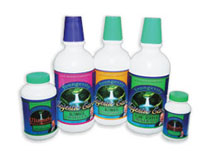

| BIOMETRICS | BEYOND ORGANIC | BLOOD/SUGAR | PROBIOTICS | DETOX | EFA's | |
| MULTI VITAMINS | MINERALS | JUST VITAMINS | INTEGRIS | SHAKES | SOZO PRODUCTS | FREELIFE |

|
I Spy Something Red When a friend first told Lori Larowe, of Troy, Mich., that her 4-year-old daughter's undesirable behavior might be caused by a reaction to red food dye, she was skeptical. "I had three kids, and none of them had any allergies that I knew of," says Larowe. "I had never even heard of kids being allergic to red dye, but since I had nothing to lose, I decided to try it." Larowe was amazed by the change in her child's behavior after red dye was eliminated from her diet. "Prior to this, I had been having to send her to her room once or twice or more a day because of her crying, screaming, kicking, tantrums, etc.," Larowe says. "I've had her off red dye for a couple months now and I can probably count on one hand the number of times she's gotten into trouble in that time." Such stories do not surprise Jane Hersey, author of Why Can't My Child Behave? and national director of the Feingold Association, a support group for parents of children who cannot tolerate artificial food additives and may be sensitive to specific foods. child eating spaghetti Hersey says she hears stories like Larowe's every day, from mothers whose children were diagnosed with attention deficit hyperactivity disorder (ADHD) or who wet the bed chronically or suffer debilitating migraines, and when the offending food or food additive was removed from the diet, the child's symptoms disappeared. "What we deal with in most people is not an allergic response but a sensitivity," says Hersey. "If your family moved to a city that was very polluted, different family members would react differently. One might have an asthmatic attack. Another would get a headache, but you wouldn't say you're allergic to pollution." Hersey became interested in this field when she discovered her own children reacted to certain food additives. "My daughter's reaction to a single gum ball was very extreme," says Hersey. "If you had seen her earlier in the day, you would say she was a normal little child, but if you saw her after her reaction started, you would have said she was severely emotionally disturbed." After removing artificial colors and additives from their diet, Hersey says her husband's migraine headaches also disappeared. Although he previously suffered from migraines that would keep him in bed for days, he has now been migraine-free for 25 years. Currently there are only seven dyes approved by the Food and Drug Administration, all made from petroleum. Red dye #3 can be used as a pesticide. "It's been used for years," says Hersey. "If you spray it on manure piles, it will kill fly eggs." Yet when the FDA tried to take it off the market, the makers of fruit cocktail lobbied to keep it available: It is the only red dye that does not bleed. According to Hersey, fruit cocktail makers said it was necessary because if the cherries were removed from their products, sales dropped. Although red dyes #3 and #40 are the only ones that can be used in food, other red dyes can be used in cosmetics and medicine. Some of those dyes have also been used as pesticides or to kill marijuana plants. "If your child gets Tylenol, they can be consuming dyes that are too harmful to be put in food," says Hersey. "Where's the logic there? If someone is not supposed to be exposed to this, why are we exposing a small, sick child to it?" Although the dye industry justifies its use of such dyes by saying the quantity is small, Hersey says that is like saying a little bit of arsenic is not harmful. Furthermore, dyes used in medicines do not have to be listed on the labels. Dr. Ronald Kleinman, professor of pediatrics at Harvard Medical School and chief of pediatric gastroenterology and nutrition at Massachusetts General Hospital, says there may be some children who are bothered by artificial dyes, but he does not believe they are responsible for a large number of children who have been diagnosed with ADHD or other behavior disorders. "It's very hard to pin down food dye as a major cause of attention deficit disorder," says Kleinman. "No child needs red food dye to survive. It's not essential to life, so for any given child, if a parent wants to do that experiment and they see that there's some marked behavior improvement, I'm not going to argue with them about that." child eating ice cream Studies have shown that some children have classic allergic reactions to red and yellow food dyes, but Kleinman would like to see more scientific studies done to correlate food dyes with behavior problems in children. Kathy Bratby, RN, MSN, a clinical assistant professor at the State University of New York at Stony Brook School of Nursing and the president of the Feingold Association, says her son's first grade teacher validated the correlation between her child's behavior and food dye at a school party where the boy consumed an artificially colored drink. "The teacher saw it within 20 minutes of him drinking a couple cups of it (the drink)," says Bratby. "She said, 'I had a different child, running around the room, bouncing off the walls.'" Bratby encourages parents to look at diet first if they have a child with behavior problems or a chronic medical problem, such as headaches or bedwetting. "Before you use medicine, use this simple method first and see if it does play a role," says Bratby. "We are not anti-medicine, but why would you treat something with medicine when you don't know what you're dealing with?" says Bratby. "You have to know what you've got before you pronounce a diagnosis." Ironically, Hersey says Ritalin -- which is the most common drug given to children with ADHD -- contains yellow dye, which could exacerbate the problem for children who are sensitive to it. Larowe did a lot of research on childhood depression, obsessive compulsive disorder and other mental diseases when trying to figure out what was wrong with her daughter. She also talked to her daughter's pediatrician, who offered no answers. "I am so thankful to my friend who told me about (the possible problems with red dye)," Larowe says. "The time I spend with my daughter is now so much more enjoyable. I actually did not like being with her a lot of the time before discovering her allergy. She was so unhappy, and it made the rest of the family unhappy, too." Although Bratby and Hersey agree that not all cases of ADHD or other behavioral problems are caused by artificial dyes, they believe it is such a simple theory to test on an individual child, it is worth the effort. "We certainly don't think that food additives are the answer or the only culprit, but we think it's a mistake not to take them into account as a huge factor, a big piece of the puzzle," says Hersey. "I feel that all parents should be more aware of red dye and what it can do to some children," says Larowe. "I would like to spread the word to as many people as I can, and hopefully help other families who are in the same situation I was in
Minerals are essential to life itself!  |

Doctor Joel Wallach and his Pig Pack Formula can be for those that are one of the 20 million Americans who has listened to Doctor Wallachs "Dead Doctors Don't Lie! - the audio tape by Dr. Joel Wallach, BS, DVM, ND, The Mineral Doctor? Doctor Wallach has advocated that this formula may comfort those with artthritis pain and associated joint problems. Pig Pack Formula from Youngevityy has made ordering the products for the Pig Pack Formula much easier. You can buy all those products at one time. Included in the pig pack is 2 Majestic Earth Minerals #13203, 2 Majestic Earth Ultimate Tangy Tangerine #13221, 1 Ultimate Gluco Gel #21251 and 1 Ultimate E.F.A. #20641 . Look also at our
Liquid
Gluco Gel with MSM,
Glucosame Sulfate, Chondroitin Sulfate, Cetylmyristoleate, and
Collagen Hydrolysate. Check out Liquid
Osteo fx an easy way to get your 1200mg of Daily Calcium
with MSM and Glucosame Sulfate. 
|
||

